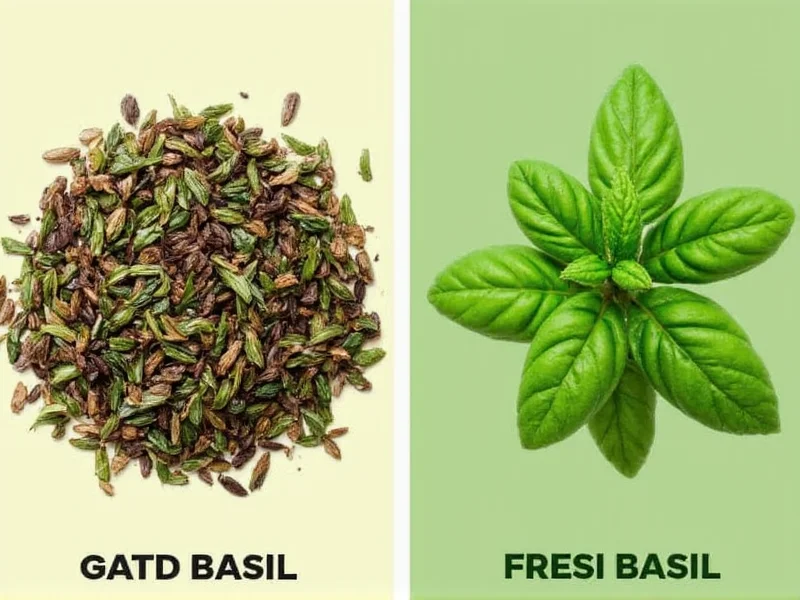Understanding herb conversions is essential for successful cooking. Dried herbs generally have a more concentrated flavor than their fresh counterparts because the drying process removes water content while preserving essential oils. This concentration effect explains why you need less dried basil than fresh in recipes.
Why Dried and Fresh Basil Have Different Potencies
Basil loses approximately 80-90% of its water content during the drying process. This dehydration concentrates the volatile oils responsible for basil's distinctive flavor and aroma. Fresh basil contains more water, making its flavor more delicate and nuanced, while dried basil delivers a more intense, earthy taste profile.
The chemical composition changes during drying too. Some delicate flavor compounds evaporate, while others become more concentrated. This is why many chefs recommend using fresh basil for finishing dishes and dried basil for longer cooking processes where flavors can meld.
Dried Basil to Fresh Basil Conversion Chart
| Dried Basil | Fresh Basil Equivalent |
|---|---|
| ¼ teaspoon | ¾ teaspoon |
| ½ teaspoon | 1½ teaspoons |
| 1 teaspoon | 1 tablespoon |
| 1½ teaspoons | 1½ tablespoons |
| 1 tablespoon | 3 tablespoons (¼ cup) |
| 2 tablespoons | 6 tablespoons (⅓ cup) |
When to Use Each Form of Basil
Understanding when to use dried versus fresh basil significantly impacts your cooking results. For dried basil substitution for fresh in recipes, consider these guidelines:
- Use dried basil in long-simmering dishes like tomato sauces, soups, and stews where it has time to rehydrate and release flavors
- Add dried basil early in the cooking process to allow its flavors to develop
- Use fresh basil for finishing dishes, in salads, or in quick-cooking recipes where delicate flavors matter
- Add fresh basil late in cooking to preserve its bright flavor and aroma
Flavor Profile Differences
The fresh basil to dried basil conversion isn't just about quantity—flavor profiles differ significantly. Fresh basil offers bright, sweet, slightly peppery notes with hints of anise. Dried basil develops deeper, more earthy characteristics with subtle minty undertones.
When making the dried basil equivalent to fresh substitution, remember that dried basil won't provide the same aromatic freshness. For dishes where basil is the star ingredient (like pesto), fresh is always preferable. For background flavor in cooked dishes, dried works well with proper measurement.
Storage Tips for Maximum Freshness
Proper storage affects potency, which impacts your basil measurement conversion chart accuracy:
- Fresh basil: Store upright in a glass with water (like flowers), loosely covered with a plastic bag in the refrigerator. Use within 5-7 days for best flavor.
- Dried basil: Keep in an airtight container away from light and heat. Properly stored, it maintains good flavor for 1-2 years (though peak quality is within 6 months).
Older dried herbs lose potency, so you might need slightly more than the standard ratio if your dried basil has been stored for more than a year. Always check dried herbs for strong aroma before using.
Recipe Conversion Examples
Understanding the how much dried basil equals fresh basil ratio becomes practical with real examples:
Tomato Sauce Recipe
Original: 3 tablespoons fresh basil
Substitution: 1 tablespoon dried basil
Pasta Salad
Original: ¼ cup fresh basil
Substitution: 1¼ tablespoons dried basil (or 1 tablespoon plus 1 teaspoon)
Caprese Dressing
Original: 2 tablespoons fresh basil
Substitution: 2 teaspoons dried basil
Common Substitution Mistakes to Avoid
When working with the dried herb to fresh herb ratio, watch for these common errors:
- Using equal amounts: Never substitute dried and fresh herbs measure-for-measure
- Adding dried herbs too late: They need time to rehydrate and release flavors
- Using old dried herbs: Stale dried basil has lost potency and won't provide proper flavor
- Overcompensating: More isn't better—excess dried basil can make dishes bitter
When in doubt about the when to use dried basil instead of fresh, start with less dried herb than you think you need. You can always add more, but you can't remove excess once incorporated.
Special Considerations for Different Cuisines
Culinary traditions affect how you should approach the cooking with dried versus fresh basil decision:
- Italian cooking: Fresh basil is preferred for most dishes, especially those served immediately
- Mediterranean dishes: Dried basil works well in spice blends and slow-cooked dishes
- Thai and Southeast Asian cuisine: Fresh holy basil is essential; dried doesn't provide the same flavor profile
Remember that different basil varieties (sweet basil, holy basil, Thai basil) have unique flavor compounds that don't always translate perfectly between fresh and dried forms.











 浙公网安备
33010002000092号
浙公网安备
33010002000092号 浙B2-20120091-4
浙B2-20120091-4